Self-Awareness and Its Impact on Organizational Behavior
VerifiedAdded on 2023/06/05
|15
|3664
|326
Report
AI Summary
This report examines the critical role of self-awareness in organizational behavior. It delves into the significance of understanding one's personality, values, and emotional intelligence, and how these factors influence leadership styles, power dynamics, and decision-making processes. The report utilizes frameworks like the Myers-Briggs Type Indicator and discusses theories of decision-making, including rational decision theory and consensus decision-making models, to provide a comprehensive analysis of self-development in a workplace context. It also explores how these concepts relate to personal career planning and the ability to overcome challenges. The report highlights the importance of emotional intelligence in managing emotions, particularly in leadership roles, and emphasizes how self-awareness enables individuals to make informed decisions and navigate organizational complexities effectively. Finally, the report connects these insights to practical applications, such as motivating employees and fostering a positive work culture.
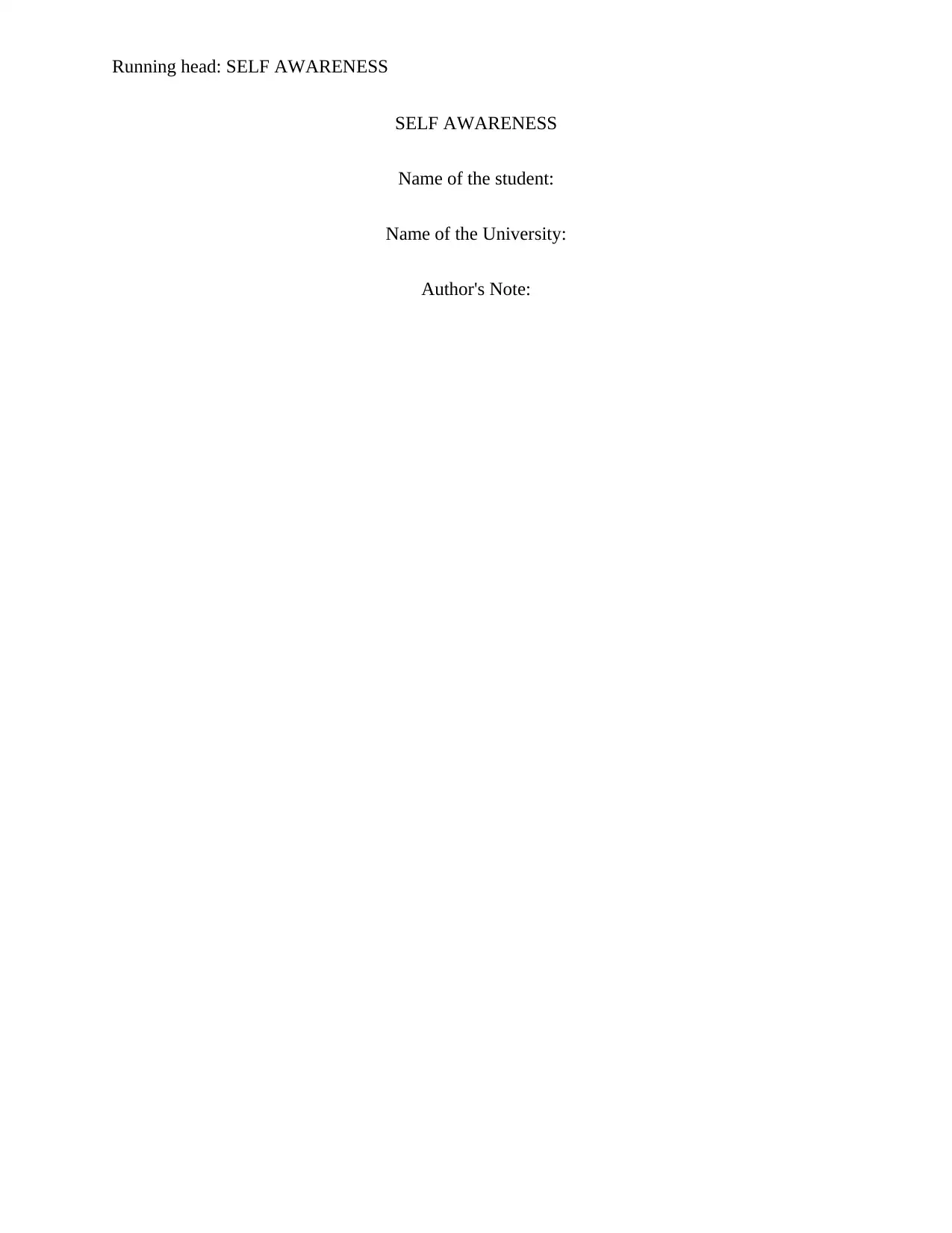
Running head: SELF AWARENESS
SELF AWARENESS
Name of the student:
Name of the University:
Author's Note:
SELF AWARENESS
Name of the student:
Name of the University:
Author's Note:
Paraphrase This Document
Need a fresh take? Get an instant paraphrase of this document with our AI Paraphraser
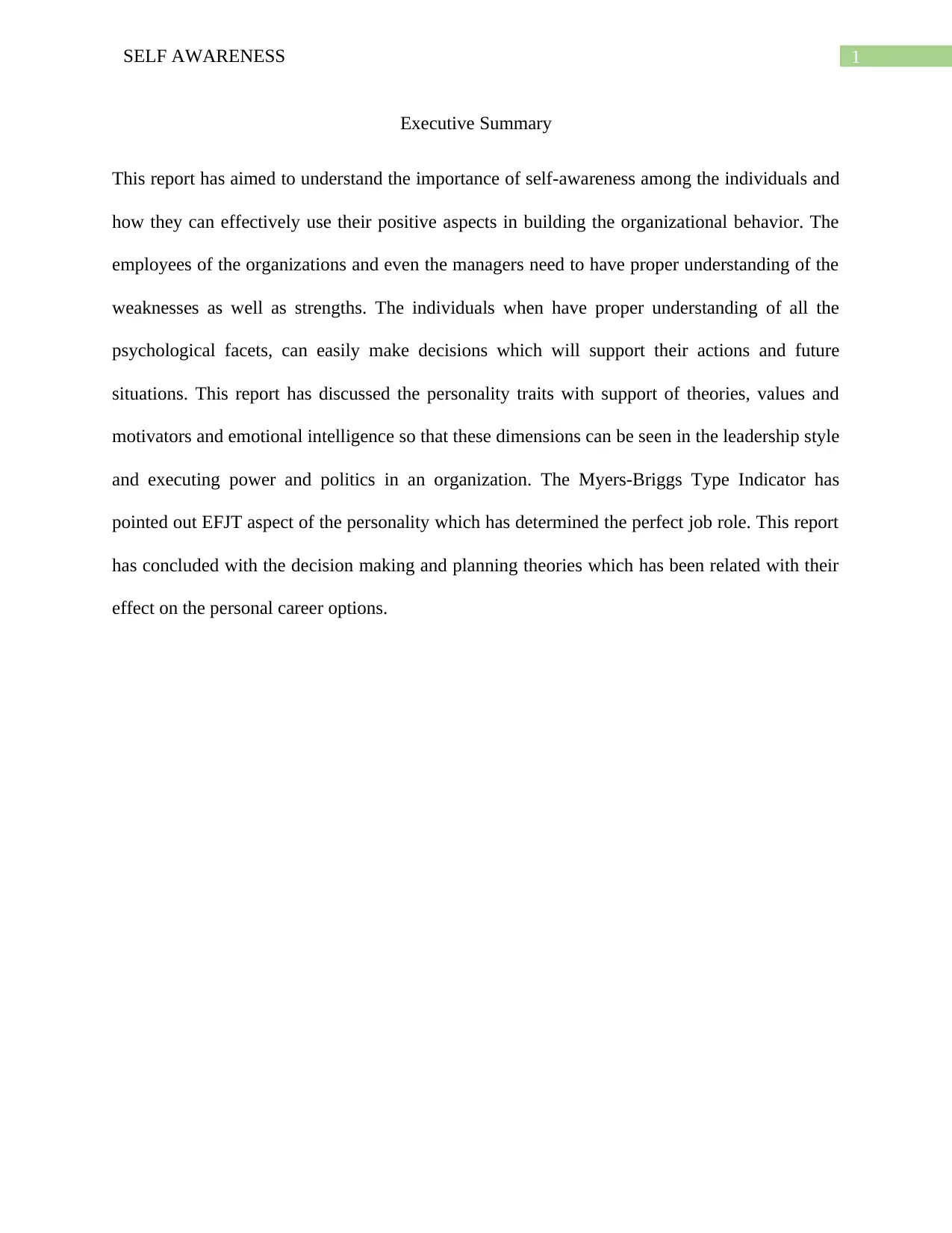
1SELF AWARENESS
Executive Summary
This report has aimed to understand the importance of self-awareness among the individuals and
how they can effectively use their positive aspects in building the organizational behavior. The
employees of the organizations and even the managers need to have proper understanding of the
weaknesses as well as strengths. The individuals when have proper understanding of all the
psychological facets, can easily make decisions which will support their actions and future
situations. This report has discussed the personality traits with support of theories, values and
motivators and emotional intelligence so that these dimensions can be seen in the leadership style
and executing power and politics in an organization. The Myers-Briggs Type Indicator has
pointed out EFJT aspect of the personality which has determined the perfect job role. This report
has concluded with the decision making and planning theories which has been related with their
effect on the personal career options.
Executive Summary
This report has aimed to understand the importance of self-awareness among the individuals and
how they can effectively use their positive aspects in building the organizational behavior. The
employees of the organizations and even the managers need to have proper understanding of the
weaknesses as well as strengths. The individuals when have proper understanding of all the
psychological facets, can easily make decisions which will support their actions and future
situations. This report has discussed the personality traits with support of theories, values and
motivators and emotional intelligence so that these dimensions can be seen in the leadership style
and executing power and politics in an organization. The Myers-Briggs Type Indicator has
pointed out EFJT aspect of the personality which has determined the perfect job role. This report
has concluded with the decision making and planning theories which has been related with their
effect on the personal career options.
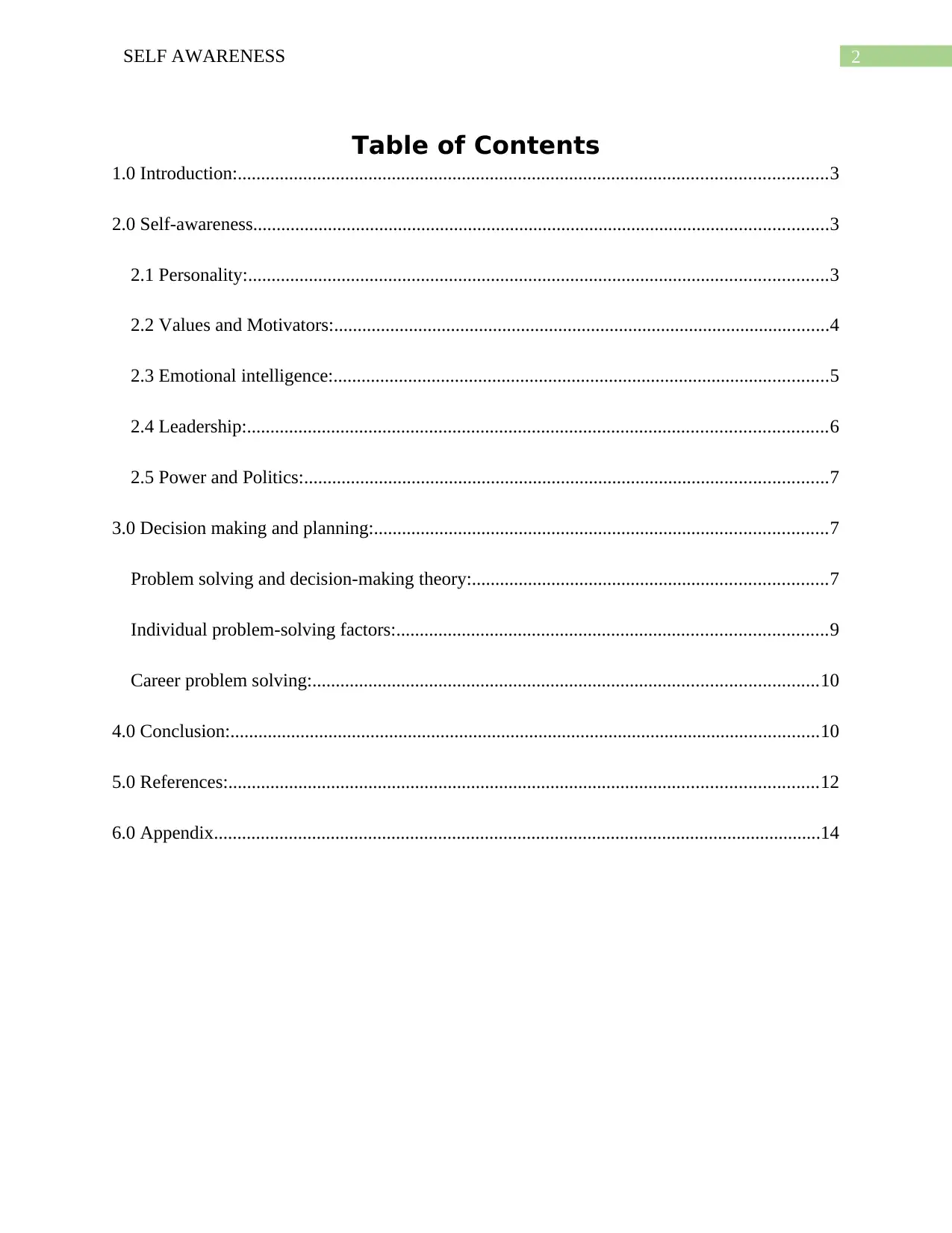
2SELF AWARENESS
Table of Contents
1.0 Introduction:..............................................................................................................................3
2.0 Self-awareness...........................................................................................................................3
2.1 Personality:............................................................................................................................3
2.2 Values and Motivators:..........................................................................................................4
2.3 Emotional intelligence:..........................................................................................................5
2.4 Leadership:............................................................................................................................6
2.5 Power and Politics:................................................................................................................7
3.0 Decision making and planning:.................................................................................................7
Problem solving and decision-making theory:............................................................................7
Individual problem-solving factors:............................................................................................9
Career problem solving:............................................................................................................10
4.0 Conclusion:..............................................................................................................................10
5.0 References:..............................................................................................................................12
6.0 Appendix..................................................................................................................................14
Table of Contents
1.0 Introduction:..............................................................................................................................3
2.0 Self-awareness...........................................................................................................................3
2.1 Personality:............................................................................................................................3
2.2 Values and Motivators:..........................................................................................................4
2.3 Emotional intelligence:..........................................................................................................5
2.4 Leadership:............................................................................................................................6
2.5 Power and Politics:................................................................................................................7
3.0 Decision making and planning:.................................................................................................7
Problem solving and decision-making theory:............................................................................7
Individual problem-solving factors:............................................................................................9
Career problem solving:............................................................................................................10
4.0 Conclusion:..............................................................................................................................10
5.0 References:..............................................................................................................................12
6.0 Appendix..................................................................................................................................14
⊘ This is a preview!⊘
Do you want full access?
Subscribe today to unlock all pages.

Trusted by 1+ million students worldwide
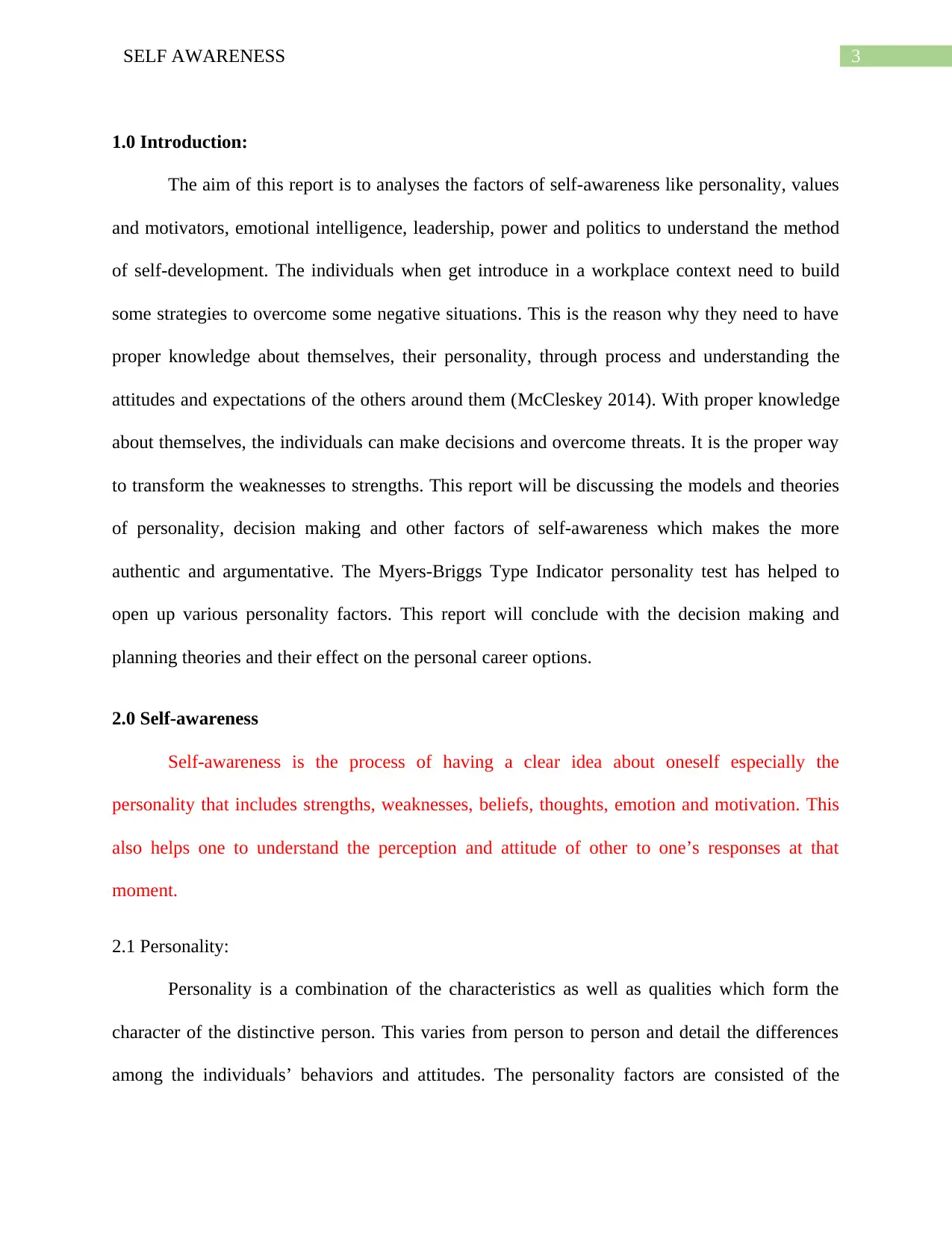
3SELF AWARENESS
1.0 Introduction:
The aim of this report is to analyses the factors of self-awareness like personality, values
and motivators, emotional intelligence, leadership, power and politics to understand the method
of self-development. The individuals when get introduce in a workplace context need to build
some strategies to overcome some negative situations. This is the reason why they need to have
proper knowledge about themselves, their personality, through process and understanding the
attitudes and expectations of the others around them (McCleskey 2014). With proper knowledge
about themselves, the individuals can make decisions and overcome threats. It is the proper way
to transform the weaknesses to strengths. This report will be discussing the models and theories
of personality, decision making and other factors of self-awareness which makes the more
authentic and argumentative. The Myers-Briggs Type Indicator personality test has helped to
open up various personality factors. This report will conclude with the decision making and
planning theories and their effect on the personal career options.
2.0 Self-awareness
Self-awareness is the process of having a clear idea about oneself especially the
personality that includes strengths, weaknesses, beliefs, thoughts, emotion and motivation. This
also helps one to understand the perception and attitude of other to one’s responses at that
moment.
2.1 Personality:
Personality is a combination of the characteristics as well as qualities which form the
character of the distinctive person. This varies from person to person and detail the differences
among the individuals’ behaviors and attitudes. The personality factors are consisted of the
1.0 Introduction:
The aim of this report is to analyses the factors of self-awareness like personality, values
and motivators, emotional intelligence, leadership, power and politics to understand the method
of self-development. The individuals when get introduce in a workplace context need to build
some strategies to overcome some negative situations. This is the reason why they need to have
proper knowledge about themselves, their personality, through process and understanding the
attitudes and expectations of the others around them (McCleskey 2014). With proper knowledge
about themselves, the individuals can make decisions and overcome threats. It is the proper way
to transform the weaknesses to strengths. This report will be discussing the models and theories
of personality, decision making and other factors of self-awareness which makes the more
authentic and argumentative. The Myers-Briggs Type Indicator personality test has helped to
open up various personality factors. This report will conclude with the decision making and
planning theories and their effect on the personal career options.
2.0 Self-awareness
Self-awareness is the process of having a clear idea about oneself especially the
personality that includes strengths, weaknesses, beliefs, thoughts, emotion and motivation. This
also helps one to understand the perception and attitude of other to one’s responses at that
moment.
2.1 Personality:
Personality is a combination of the characteristics as well as qualities which form the
character of the distinctive person. This varies from person to person and detail the differences
among the individuals’ behaviors and attitudes. The personality factors are consisted of the
Paraphrase This Document
Need a fresh take? Get an instant paraphrase of this document with our AI Paraphraser
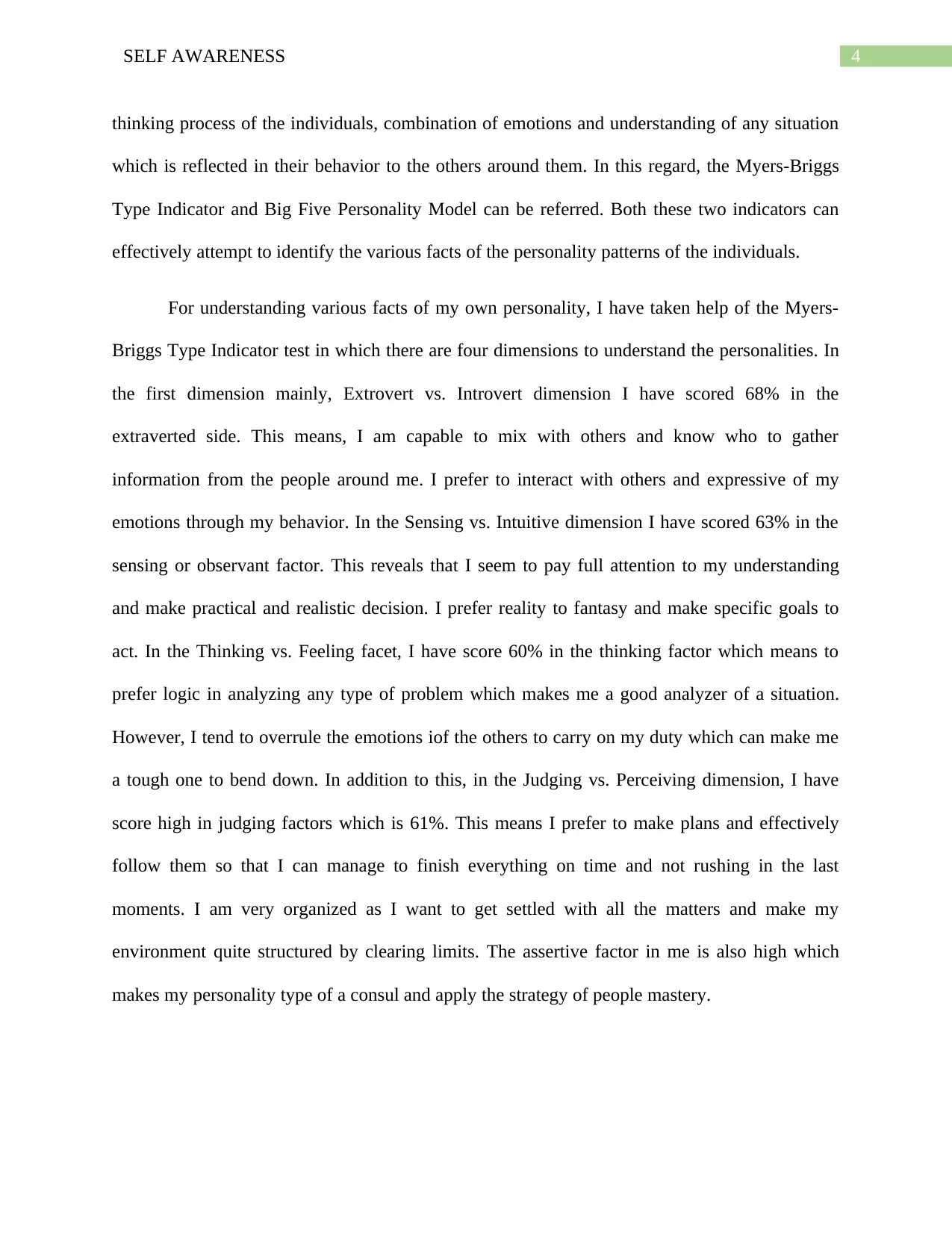
4SELF AWARENESS
thinking process of the individuals, combination of emotions and understanding of any situation
which is reflected in their behavior to the others around them. In this regard, the Myers-Briggs
Type Indicator and Big Five Personality Model can be referred. Both these two indicators can
effectively attempt to identify the various facts of the personality patterns of the individuals.
For understanding various facts of my own personality, I have taken help of the Myers-
Briggs Type Indicator test in which there are four dimensions to understand the personalities. In
the first dimension mainly, Extrovert vs. Introvert dimension I have scored 68% in the
extraverted side. This means, I am capable to mix with others and know who to gather
information from the people around me. I prefer to interact with others and expressive of my
emotions through my behavior. In the Sensing vs. Intuitive dimension I have scored 63% in the
sensing or observant factor. This reveals that I seem to pay full attention to my understanding
and make practical and realistic decision. I prefer reality to fantasy and make specific goals to
act. In the Thinking vs. Feeling facet, I have score 60% in the thinking factor which means to
prefer logic in analyzing any type of problem which makes me a good analyzer of a situation.
However, I tend to overrule the emotions iof the others to carry on my duty which can make me
a tough one to bend down. In addition to this, in the Judging vs. Perceiving dimension, I have
score high in judging factors which is 61%. This means I prefer to make plans and effectively
follow them so that I can manage to finish everything on time and not rushing in the last
moments. I am very organized as I want to get settled with all the matters and make my
environment quite structured by clearing limits. The assertive factor in me is also high which
makes my personality type of a consul and apply the strategy of people mastery.
thinking process of the individuals, combination of emotions and understanding of any situation
which is reflected in their behavior to the others around them. In this regard, the Myers-Briggs
Type Indicator and Big Five Personality Model can be referred. Both these two indicators can
effectively attempt to identify the various facts of the personality patterns of the individuals.
For understanding various facts of my own personality, I have taken help of the Myers-
Briggs Type Indicator test in which there are four dimensions to understand the personalities. In
the first dimension mainly, Extrovert vs. Introvert dimension I have scored 68% in the
extraverted side. This means, I am capable to mix with others and know who to gather
information from the people around me. I prefer to interact with others and expressive of my
emotions through my behavior. In the Sensing vs. Intuitive dimension I have scored 63% in the
sensing or observant factor. This reveals that I seem to pay full attention to my understanding
and make practical and realistic decision. I prefer reality to fantasy and make specific goals to
act. In the Thinking vs. Feeling facet, I have score 60% in the thinking factor which means to
prefer logic in analyzing any type of problem which makes me a good analyzer of a situation.
However, I tend to overrule the emotions iof the others to carry on my duty which can make me
a tough one to bend down. In addition to this, in the Judging vs. Perceiving dimension, I have
score high in judging factors which is 61%. This means I prefer to make plans and effectively
follow them so that I can manage to finish everything on time and not rushing in the last
moments. I am very organized as I want to get settled with all the matters and make my
environment quite structured by clearing limits. The assertive factor in me is also high which
makes my personality type of a consul and apply the strategy of people mastery.
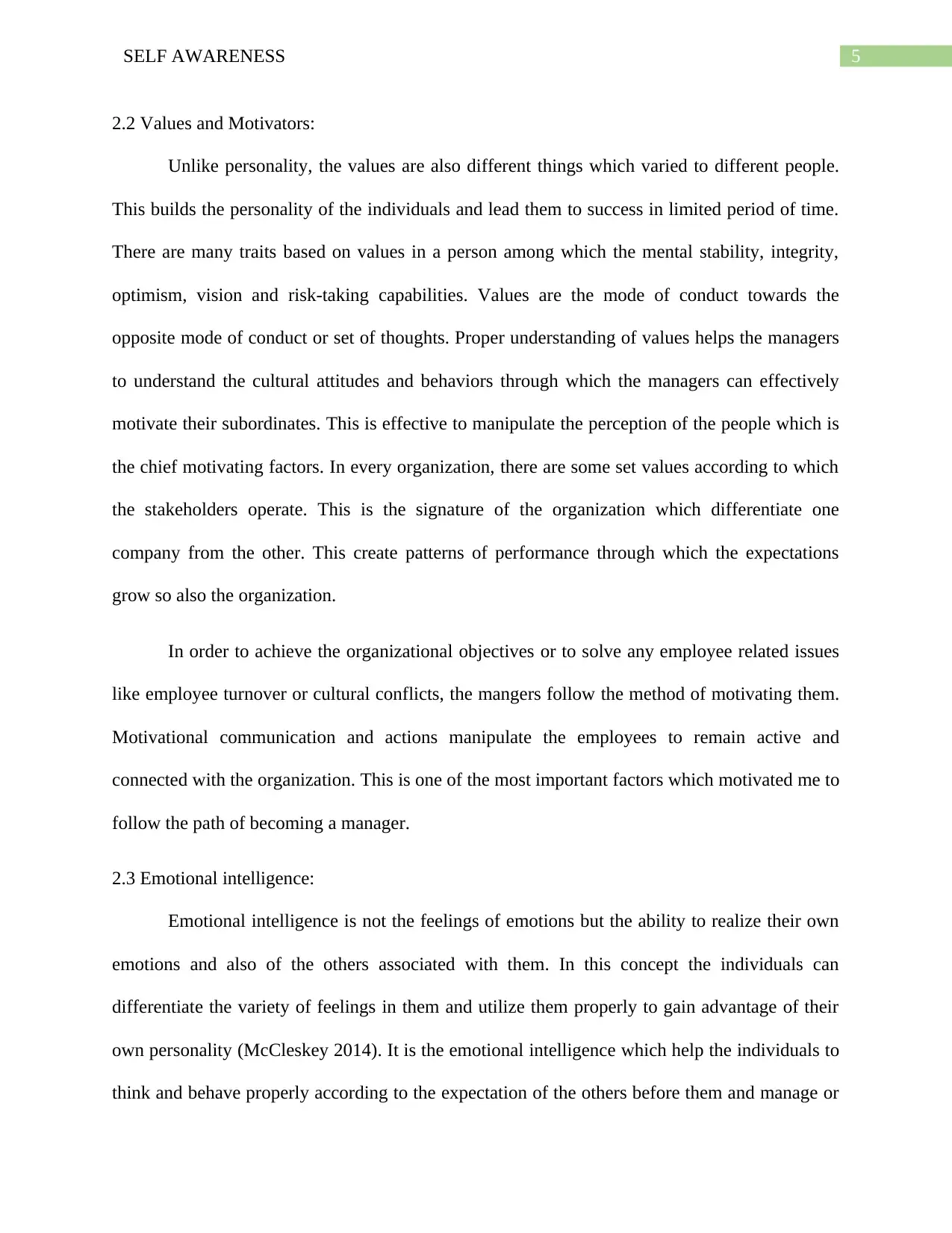
5SELF AWARENESS
2.2 Values and Motivators:
Unlike personality, the values are also different things which varied to different people.
This builds the personality of the individuals and lead them to success in limited period of time.
There are many traits based on values in a person among which the mental stability, integrity,
optimism, vision and risk-taking capabilities. Values are the mode of conduct towards the
opposite mode of conduct or set of thoughts. Proper understanding of values helps the managers
to understand the cultural attitudes and behaviors through which the managers can effectively
motivate their subordinates. This is effective to manipulate the perception of the people which is
the chief motivating factors. In every organization, there are some set values according to which
the stakeholders operate. This is the signature of the organization which differentiate one
company from the other. This create patterns of performance through which the expectations
grow so also the organization.
In order to achieve the organizational objectives or to solve any employee related issues
like employee turnover or cultural conflicts, the mangers follow the method of motivating them.
Motivational communication and actions manipulate the employees to remain active and
connected with the organization. This is one of the most important factors which motivated me to
follow the path of becoming a manager.
2.3 Emotional intelligence:
Emotional intelligence is not the feelings of emotions but the ability to realize their own
emotions and also of the others associated with them. In this concept the individuals can
differentiate the variety of feelings in them and utilize them properly to gain advantage of their
own personality (McCleskey 2014). It is the emotional intelligence which help the individuals to
think and behave properly according to the expectation of the others before them and manage or
2.2 Values and Motivators:
Unlike personality, the values are also different things which varied to different people.
This builds the personality of the individuals and lead them to success in limited period of time.
There are many traits based on values in a person among which the mental stability, integrity,
optimism, vision and risk-taking capabilities. Values are the mode of conduct towards the
opposite mode of conduct or set of thoughts. Proper understanding of values helps the managers
to understand the cultural attitudes and behaviors through which the managers can effectively
motivate their subordinates. This is effective to manipulate the perception of the people which is
the chief motivating factors. In every organization, there are some set values according to which
the stakeholders operate. This is the signature of the organization which differentiate one
company from the other. This create patterns of performance through which the expectations
grow so also the organization.
In order to achieve the organizational objectives or to solve any employee related issues
like employee turnover or cultural conflicts, the mangers follow the method of motivating them.
Motivational communication and actions manipulate the employees to remain active and
connected with the organization. This is one of the most important factors which motivated me to
follow the path of becoming a manager.
2.3 Emotional intelligence:
Emotional intelligence is not the feelings of emotions but the ability to realize their own
emotions and also of the others associated with them. In this concept the individuals can
differentiate the variety of feelings in them and utilize them properly to gain advantage of their
own personality (McCleskey 2014). It is the emotional intelligence which help the individuals to
think and behave properly according to the expectation of the others before them and manage or
⊘ This is a preview!⊘
Do you want full access?
Subscribe today to unlock all pages.

Trusted by 1+ million students worldwide
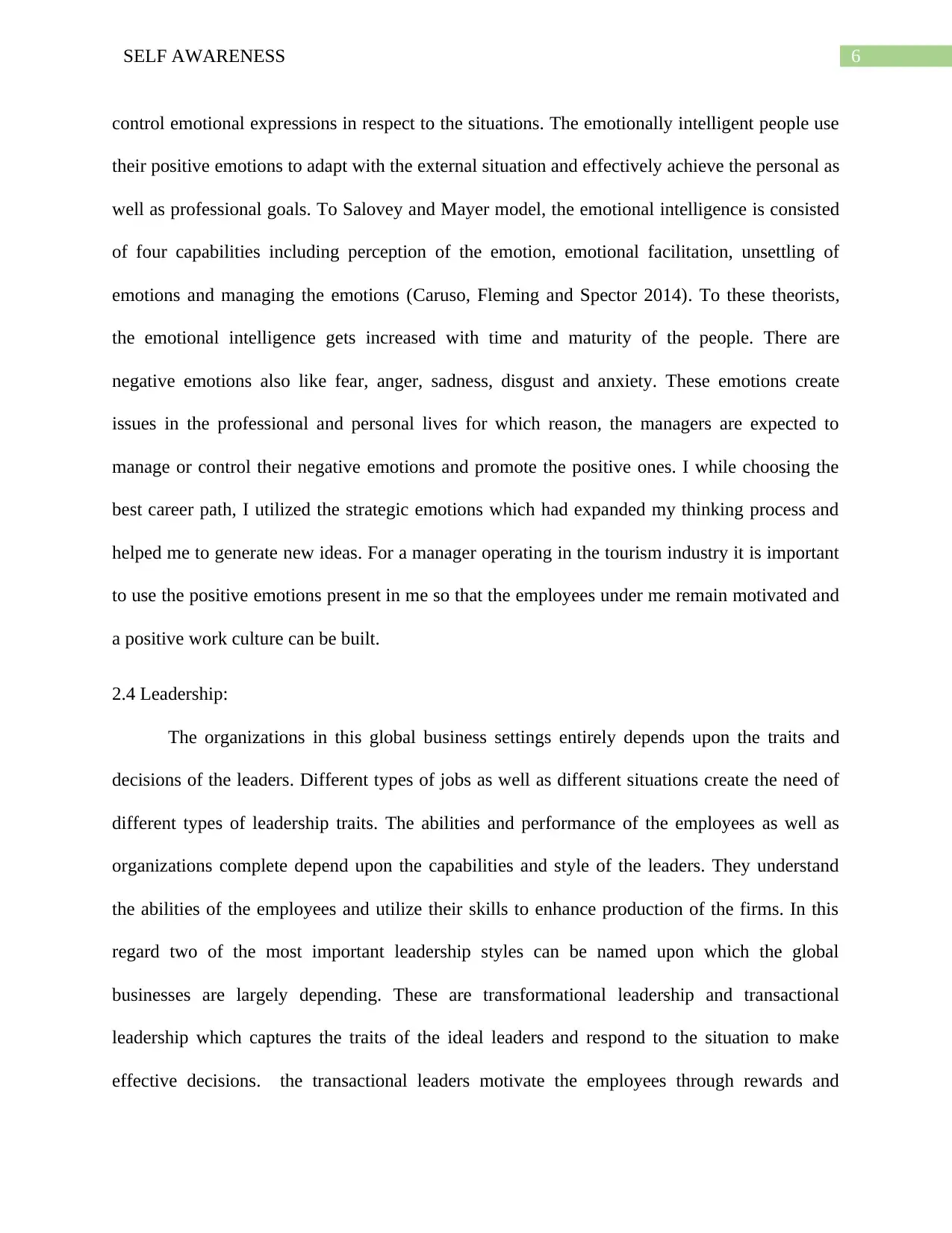
6SELF AWARENESS
control emotional expressions in respect to the situations. The emotionally intelligent people use
their positive emotions to adapt with the external situation and effectively achieve the personal as
well as professional goals. To Salovey and Mayer model, the emotional intelligence is consisted
of four capabilities including perception of the emotion, emotional facilitation, unsettling of
emotions and managing the emotions (Caruso, Fleming and Spector 2014). To these theorists,
the emotional intelligence gets increased with time and maturity of the people. There are
negative emotions also like fear, anger, sadness, disgust and anxiety. These emotions create
issues in the professional and personal lives for which reason, the managers are expected to
manage or control their negative emotions and promote the positive ones. I while choosing the
best career path, I utilized the strategic emotions which had expanded my thinking process and
helped me to generate new ideas. For a manager operating in the tourism industry it is important
to use the positive emotions present in me so that the employees under me remain motivated and
a positive work culture can be built.
2.4 Leadership:
The organizations in this global business settings entirely depends upon the traits and
decisions of the leaders. Different types of jobs as well as different situations create the need of
different types of leadership traits. The abilities and performance of the employees as well as
organizations complete depend upon the capabilities and style of the leaders. They understand
the abilities of the employees and utilize their skills to enhance production of the firms. In this
regard two of the most important leadership styles can be named upon which the global
businesses are largely depending. These are transformational leadership and transactional
leadership which captures the traits of the ideal leaders and respond to the situation to make
effective decisions. the transactional leaders motivate the employees through rewards and
control emotional expressions in respect to the situations. The emotionally intelligent people use
their positive emotions to adapt with the external situation and effectively achieve the personal as
well as professional goals. To Salovey and Mayer model, the emotional intelligence is consisted
of four capabilities including perception of the emotion, emotional facilitation, unsettling of
emotions and managing the emotions (Caruso, Fleming and Spector 2014). To these theorists,
the emotional intelligence gets increased with time and maturity of the people. There are
negative emotions also like fear, anger, sadness, disgust and anxiety. These emotions create
issues in the professional and personal lives for which reason, the managers are expected to
manage or control their negative emotions and promote the positive ones. I while choosing the
best career path, I utilized the strategic emotions which had expanded my thinking process and
helped me to generate new ideas. For a manager operating in the tourism industry it is important
to use the positive emotions present in me so that the employees under me remain motivated and
a positive work culture can be built.
2.4 Leadership:
The organizations in this global business settings entirely depends upon the traits and
decisions of the leaders. Different types of jobs as well as different situations create the need of
different types of leadership traits. The abilities and performance of the employees as well as
organizations complete depend upon the capabilities and style of the leaders. They understand
the abilities of the employees and utilize their skills to enhance production of the firms. In this
regard two of the most important leadership styles can be named upon which the global
businesses are largely depending. These are transformational leadership and transactional
leadership which captures the traits of the ideal leaders and respond to the situation to make
effective decisions. the transactional leaders motivate the employees through rewards and
Paraphrase This Document
Need a fresh take? Get an instant paraphrase of this document with our AI Paraphraser
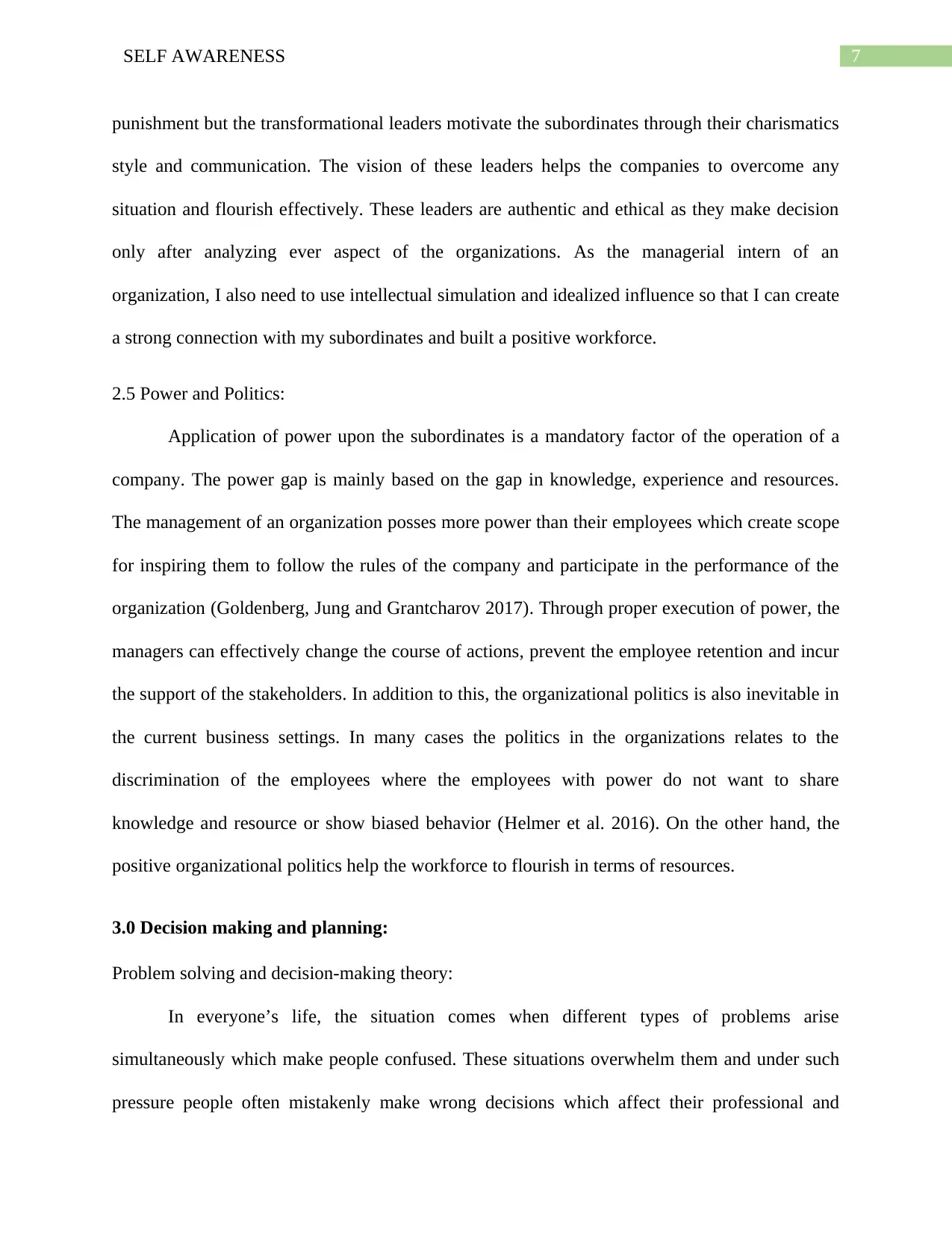
7SELF AWARENESS
punishment but the transformational leaders motivate the subordinates through their charismatics
style and communication. The vision of these leaders helps the companies to overcome any
situation and flourish effectively. These leaders are authentic and ethical as they make decision
only after analyzing ever aspect of the organizations. As the managerial intern of an
organization, I also need to use intellectual simulation and idealized influence so that I can create
a strong connection with my subordinates and built a positive workforce.
2.5 Power and Politics:
Application of power upon the subordinates is a mandatory factor of the operation of a
company. The power gap is mainly based on the gap in knowledge, experience and resources.
The management of an organization posses more power than their employees which create scope
for inspiring them to follow the rules of the company and participate in the performance of the
organization (Goldenberg, Jung and Grantcharov 2017). Through proper execution of power, the
managers can effectively change the course of actions, prevent the employee retention and incur
the support of the stakeholders. In addition to this, the organizational politics is also inevitable in
the current business settings. In many cases the politics in the organizations relates to the
discrimination of the employees where the employees with power do not want to share
knowledge and resource or show biased behavior (Helmer et al. 2016). On the other hand, the
positive organizational politics help the workforce to flourish in terms of resources.
3.0 Decision making and planning:
Problem solving and decision-making theory:
In everyone’s life, the situation comes when different types of problems arise
simultaneously which make people confused. These situations overwhelm them and under such
pressure people often mistakenly make wrong decisions which affect their professional and
punishment but the transformational leaders motivate the subordinates through their charismatics
style and communication. The vision of these leaders helps the companies to overcome any
situation and flourish effectively. These leaders are authentic and ethical as they make decision
only after analyzing ever aspect of the organizations. As the managerial intern of an
organization, I also need to use intellectual simulation and idealized influence so that I can create
a strong connection with my subordinates and built a positive workforce.
2.5 Power and Politics:
Application of power upon the subordinates is a mandatory factor of the operation of a
company. The power gap is mainly based on the gap in knowledge, experience and resources.
The management of an organization posses more power than their employees which create scope
for inspiring them to follow the rules of the company and participate in the performance of the
organization (Goldenberg, Jung and Grantcharov 2017). Through proper execution of power, the
managers can effectively change the course of actions, prevent the employee retention and incur
the support of the stakeholders. In addition to this, the organizational politics is also inevitable in
the current business settings. In many cases the politics in the organizations relates to the
discrimination of the employees where the employees with power do not want to share
knowledge and resource or show biased behavior (Helmer et al. 2016). On the other hand, the
positive organizational politics help the workforce to flourish in terms of resources.
3.0 Decision making and planning:
Problem solving and decision-making theory:
In everyone’s life, the situation comes when different types of problems arise
simultaneously which make people confused. These situations overwhelm them and under such
pressure people often mistakenly make wrong decisions which affect their professional and
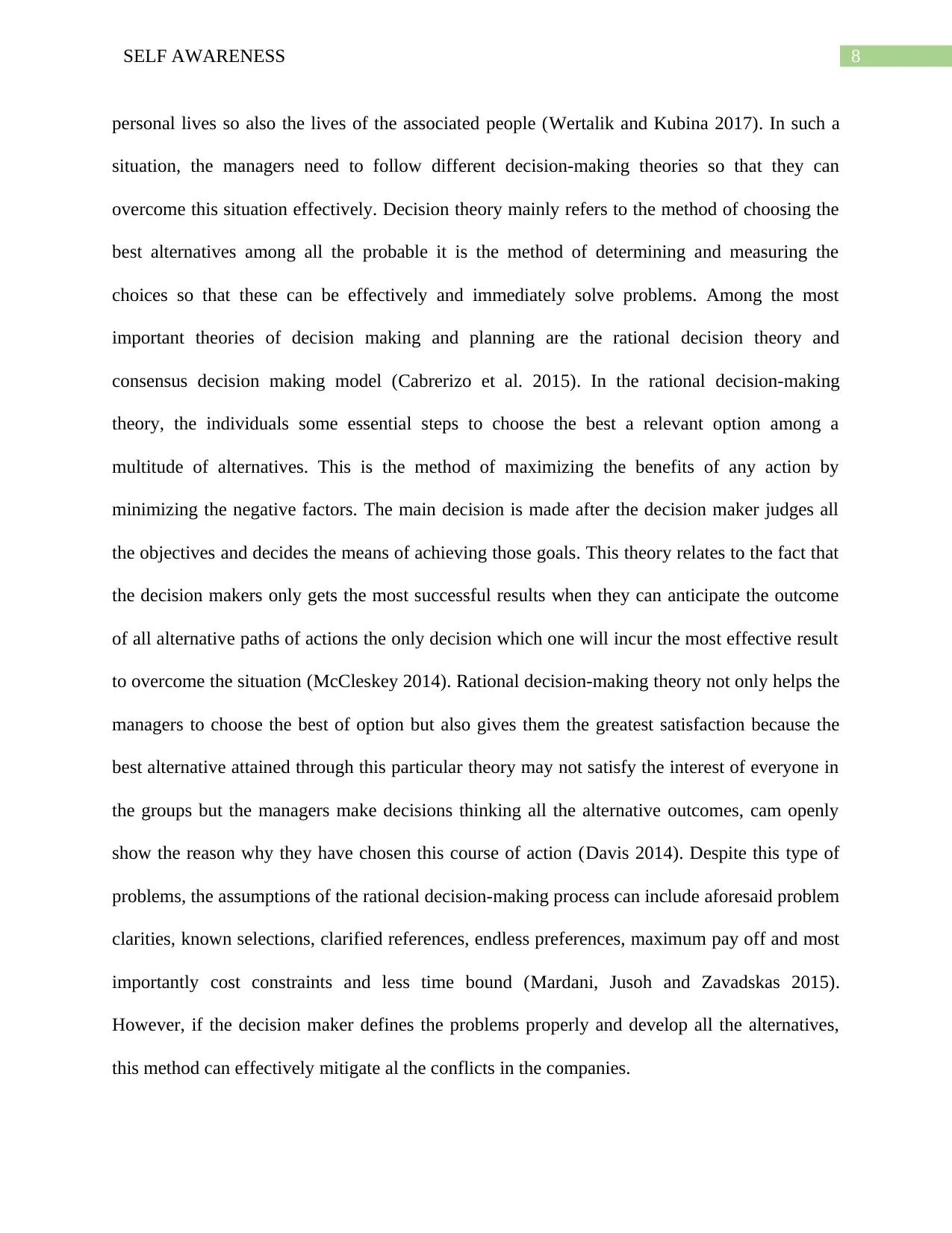
8SELF AWARENESS
personal lives so also the lives of the associated people (Wertalik and Kubina 2017). In such a
situation, the managers need to follow different decision-making theories so that they can
overcome this situation effectively. Decision theory mainly refers to the method of choosing the
best alternatives among all the probable it is the method of determining and measuring the
choices so that these can be effectively and immediately solve problems. Among the most
important theories of decision making and planning are the rational decision theory and
consensus decision making model (Cabrerizo et al. 2015). In the rational decision-making
theory, the individuals some essential steps to choose the best a relevant option among a
multitude of alternatives. This is the method of maximizing the benefits of any action by
minimizing the negative factors. The main decision is made after the decision maker judges all
the objectives and decides the means of achieving those goals. This theory relates to the fact that
the decision makers only gets the most successful results when they can anticipate the outcome
of all alternative paths of actions the only decision which one will incur the most effective result
to overcome the situation (McCleskey 2014). Rational decision-making theory not only helps the
managers to choose the best of option but also gives them the greatest satisfaction because the
best alternative attained through this particular theory may not satisfy the interest of everyone in
the groups but the managers make decisions thinking all the alternative outcomes, cam openly
show the reason why they have chosen this course of action (Davis 2014). Despite this type of
problems, the assumptions of the rational decision-making process can include aforesaid problem
clarities, known selections, clarified references, endless preferences, maximum pay off and most
importantly cost constraints and less time bound (Mardani, Jusoh and Zavadskas 2015).
However, if the decision maker defines the problems properly and develop all the alternatives,
this method can effectively mitigate al the conflicts in the companies.
personal lives so also the lives of the associated people (Wertalik and Kubina 2017). In such a
situation, the managers need to follow different decision-making theories so that they can
overcome this situation effectively. Decision theory mainly refers to the method of choosing the
best alternatives among all the probable it is the method of determining and measuring the
choices so that these can be effectively and immediately solve problems. Among the most
important theories of decision making and planning are the rational decision theory and
consensus decision making model (Cabrerizo et al. 2015). In the rational decision-making
theory, the individuals some essential steps to choose the best a relevant option among a
multitude of alternatives. This is the method of maximizing the benefits of any action by
minimizing the negative factors. The main decision is made after the decision maker judges all
the objectives and decides the means of achieving those goals. This theory relates to the fact that
the decision makers only gets the most successful results when they can anticipate the outcome
of all alternative paths of actions the only decision which one will incur the most effective result
to overcome the situation (McCleskey 2014). Rational decision-making theory not only helps the
managers to choose the best of option but also gives them the greatest satisfaction because the
best alternative attained through this particular theory may not satisfy the interest of everyone in
the groups but the managers make decisions thinking all the alternative outcomes, cam openly
show the reason why they have chosen this course of action (Davis 2014). Despite this type of
problems, the assumptions of the rational decision-making process can include aforesaid problem
clarities, known selections, clarified references, endless preferences, maximum pay off and most
importantly cost constraints and less time bound (Mardani, Jusoh and Zavadskas 2015).
However, if the decision maker defines the problems properly and develop all the alternatives,
this method can effectively mitigate al the conflicts in the companies.
⊘ This is a preview!⊘
Do you want full access?
Subscribe today to unlock all pages.

Trusted by 1+ million students worldwide
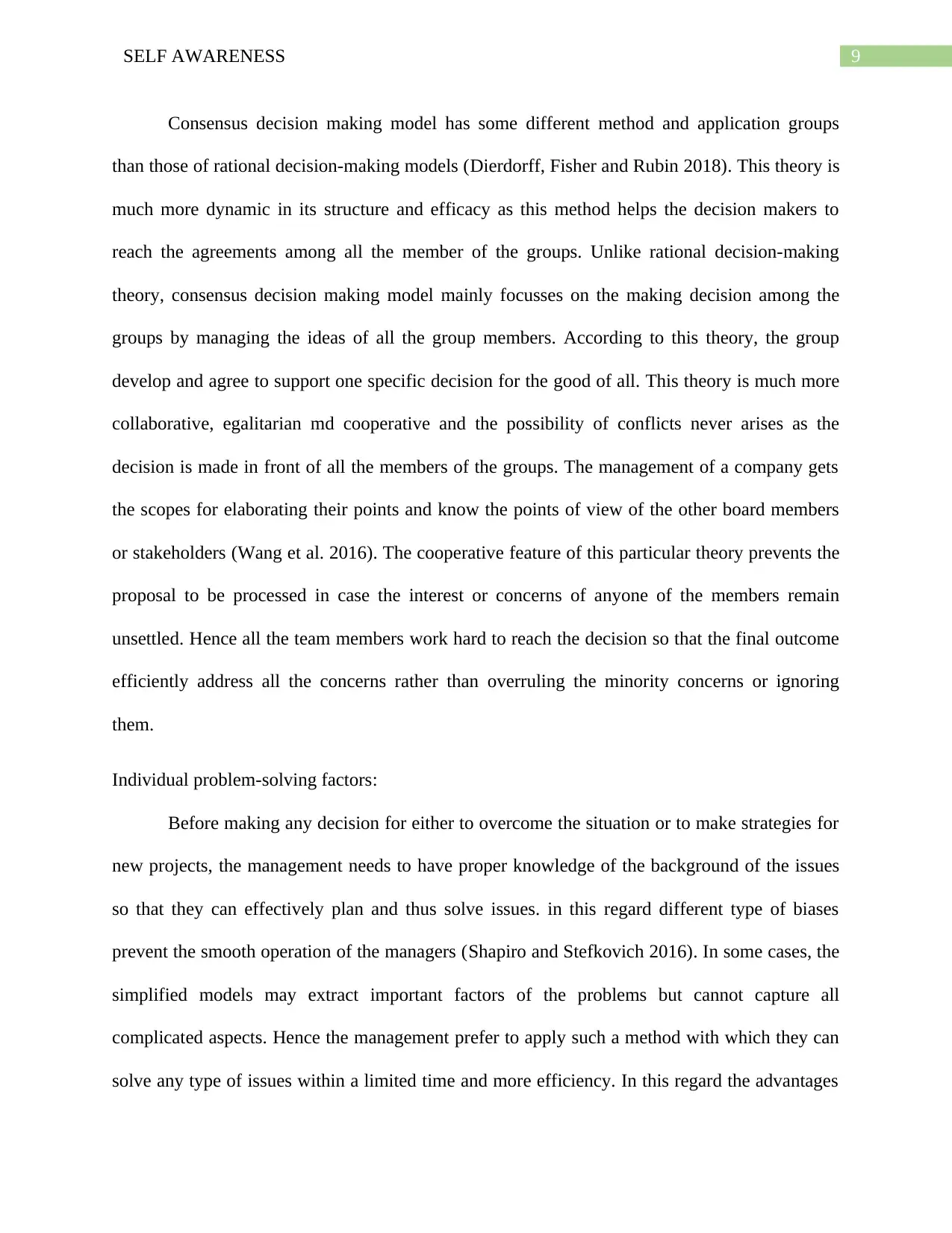
9SELF AWARENESS
Consensus decision making model has some different method and application groups
than those of rational decision-making models (Dierdorff, Fisher and Rubin 2018). This theory is
much more dynamic in its structure and efficacy as this method helps the decision makers to
reach the agreements among all the member of the groups. Unlike rational decision-making
theory, consensus decision making model mainly focusses on the making decision among the
groups by managing the ideas of all the group members. According to this theory, the group
develop and agree to support one specific decision for the good of all. This theory is much more
collaborative, egalitarian md cooperative and the possibility of conflicts never arises as the
decision is made in front of all the members of the groups. The management of a company gets
the scopes for elaborating their points and know the points of view of the other board members
or stakeholders (Wang et al. 2016). The cooperative feature of this particular theory prevents the
proposal to be processed in case the interest or concerns of anyone of the members remain
unsettled. Hence all the team members work hard to reach the decision so that the final outcome
efficiently address all the concerns rather than overruling the minority concerns or ignoring
them.
Individual problem-solving factors:
Before making any decision for either to overcome the situation or to make strategies for
new projects, the management needs to have proper knowledge of the background of the issues
so that they can effectively plan and thus solve issues. in this regard different type of biases
prevent the smooth operation of the managers (Shapiro and Stefkovich 2016). In some cases, the
simplified models may extract important factors of the problems but cannot capture all
complicated aspects. Hence the management prefer to apply such a method with which they can
solve any type of issues within a limited time and more efficiency. In this regard the advantages
Consensus decision making model has some different method and application groups
than those of rational decision-making models (Dierdorff, Fisher and Rubin 2018). This theory is
much more dynamic in its structure and efficacy as this method helps the decision makers to
reach the agreements among all the member of the groups. Unlike rational decision-making
theory, consensus decision making model mainly focusses on the making decision among the
groups by managing the ideas of all the group members. According to this theory, the group
develop and agree to support one specific decision for the good of all. This theory is much more
collaborative, egalitarian md cooperative and the possibility of conflicts never arises as the
decision is made in front of all the members of the groups. The management of a company gets
the scopes for elaborating their points and know the points of view of the other board members
or stakeholders (Wang et al. 2016). The cooperative feature of this particular theory prevents the
proposal to be processed in case the interest or concerns of anyone of the members remain
unsettled. Hence all the team members work hard to reach the decision so that the final outcome
efficiently address all the concerns rather than overruling the minority concerns or ignoring
them.
Individual problem-solving factors:
Before making any decision for either to overcome the situation or to make strategies for
new projects, the management needs to have proper knowledge of the background of the issues
so that they can effectively plan and thus solve issues. in this regard different type of biases
prevent the smooth operation of the managers (Shapiro and Stefkovich 2016). In some cases, the
simplified models may extract important factors of the problems but cannot capture all
complicated aspects. Hence the management prefer to apply such a method with which they can
solve any type of issues within a limited time and more efficiency. In this regard the advantages
Paraphrase This Document
Need a fresh take? Get an instant paraphrase of this document with our AI Paraphraser

10SELF AWARENESS
of rational decision-making model can be more appropriate as this helps the individuals to think
different aspects of the problems them find the solution for any issue (Mardani, Jusoh and
Zavadskas 2015). As this does not involve in the group discussion process, needs less time than
the consensus decision making model and more problems ca be solved quite easily. Through this
particular model, the individuals get the scope for gaining more knowledge and equation of the
issues.
Career problem solving:
In the process of deciding which way I must choose in the future as my profession, I
followed the rational decision-making model. Based on this method I could efficiently define
the problems and identified decision criteria. In perusing my ambition to become a manager in a
reputed tourism company, I had to make decides by overcoming several problems. The main
problems that I faced was the unavailability of the organizations in my area so that I can develop
skills and talents as a manager by attending an organization. This geographic and
underdeveloped regional problem first prevented me to make an individual and important
decision of life. In addition to this the cultural problems and biases to communicate and negotiate
with the other students and later internes working with me was quite difficult (Caruso, Fleming
and Spector 2014). This is the reason why I allocated different weights to different criteria and
developed the alternatives. The achievement striving personality in me compelled me to achieve
my ambition and goals hence selected the best alternatives by evaluating all of them. I decided to
join a university far away my locality and resided there to complete the course so that I can
become a manager of a reputed tourism company (Betsch 2014). This decision was ethical as this
did neither affected any of my family members’ interests nor of myself.
of rational decision-making model can be more appropriate as this helps the individuals to think
different aspects of the problems them find the solution for any issue (Mardani, Jusoh and
Zavadskas 2015). As this does not involve in the group discussion process, needs less time than
the consensus decision making model and more problems ca be solved quite easily. Through this
particular model, the individuals get the scope for gaining more knowledge and equation of the
issues.
Career problem solving:
In the process of deciding which way I must choose in the future as my profession, I
followed the rational decision-making model. Based on this method I could efficiently define
the problems and identified decision criteria. In perusing my ambition to become a manager in a
reputed tourism company, I had to make decides by overcoming several problems. The main
problems that I faced was the unavailability of the organizations in my area so that I can develop
skills and talents as a manager by attending an organization. This geographic and
underdeveloped regional problem first prevented me to make an individual and important
decision of life. In addition to this the cultural problems and biases to communicate and negotiate
with the other students and later internes working with me was quite difficult (Caruso, Fleming
and Spector 2014). This is the reason why I allocated different weights to different criteria and
developed the alternatives. The achievement striving personality in me compelled me to achieve
my ambition and goals hence selected the best alternatives by evaluating all of them. I decided to
join a university far away my locality and resided there to complete the course so that I can
become a manager of a reputed tourism company (Betsch 2014). This decision was ethical as this
did neither affected any of my family members’ interests nor of myself.
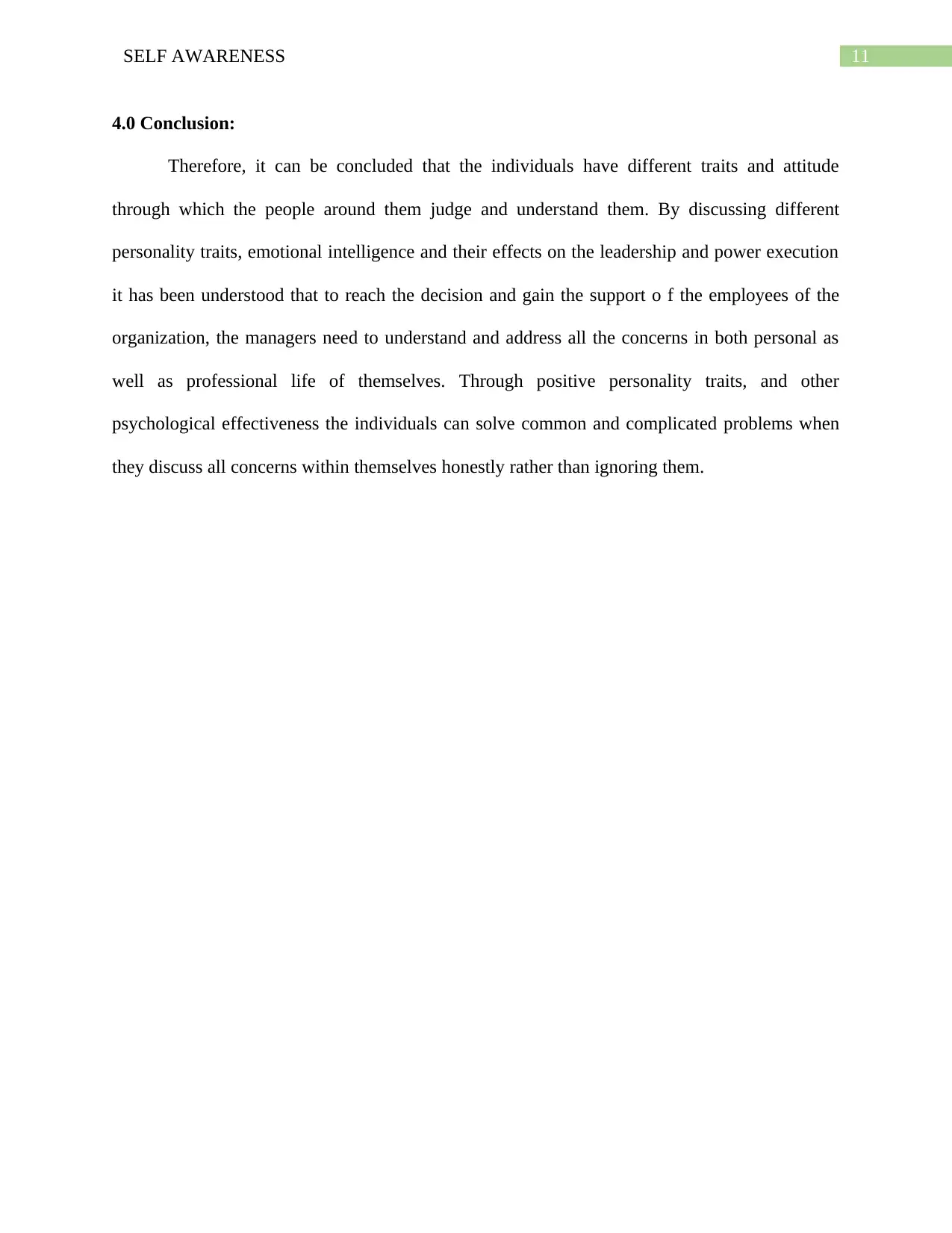
11SELF AWARENESS
4.0 Conclusion:
Therefore, it can be concluded that the individuals have different traits and attitude
through which the people around them judge and understand them. By discussing different
personality traits, emotional intelligence and their effects on the leadership and power execution
it has been understood that to reach the decision and gain the support o f the employees of the
organization, the managers need to understand and address all the concerns in both personal as
well as professional life of themselves. Through positive personality traits, and other
psychological effectiveness the individuals can solve common and complicated problems when
they discuss all concerns within themselves honestly rather than ignoring them.
4.0 Conclusion:
Therefore, it can be concluded that the individuals have different traits and attitude
through which the people around them judge and understand them. By discussing different
personality traits, emotional intelligence and their effects on the leadership and power execution
it has been understood that to reach the decision and gain the support o f the employees of the
organization, the managers need to understand and address all the concerns in both personal as
well as professional life of themselves. Through positive personality traits, and other
psychological effectiveness the individuals can solve common and complicated problems when
they discuss all concerns within themselves honestly rather than ignoring them.
⊘ This is a preview!⊘
Do you want full access?
Subscribe today to unlock all pages.

Trusted by 1+ million students worldwide
1 out of 15
Related Documents
Your All-in-One AI-Powered Toolkit for Academic Success.
+13062052269
info@desklib.com
Available 24*7 on WhatsApp / Email
![[object Object]](/_next/static/media/star-bottom.7253800d.svg)
Unlock your academic potential
Copyright © 2020–2025 A2Z Services. All Rights Reserved. Developed and managed by ZUCOL.



